
Great Pacific Gold Announces New High-Grade Assays at Comet Discovery Including 4m at 22.3 g/t Gold

Great Pacific Gold Corp. (TSX-V: GPAC) (OTCQX: FSXLF) (Germany: 4TU) is pleased to announce new high-grade gold assays from a follow up diamond drill hole of the Comet gold discovery at the Lauriston Gold Project in Victoria, Australia (Figure 1). Diamond drill hole CDH10 intersected 4.0 at 22.3 g/t Gold from 101.9m.
This high-grade intercept, together with additional gold assays received, occur within and below the previously identified main zone of the initial high-grade reverse circulation percussion discovery hole CRC07 (8m at 106 g/t Gold including 5m at 166 g/t Gold including 2m at 413 g/t Gold including 1m at 468 g/t Gold and 1m at 358 g/t Gold (from 95 metres) (see news release January 11, 2024)).
In addition to the high-grade gold assays from CDH10, the Company also received a number of deeper high-grade gold intervals from diamond drill hole CDH09 including 0.35m at 55.6 g/t Gold from 130.4m, 0.2m at 22.23 g/t Gold from 133.8m and 0.2m at 15.67 g/t Gold from 170.75m. These high-grade assays at depth show the significant potential of the system being drilled at Comet (see Figure 2 – Updated Comet Cross Section below).
GPAC Chief Operating Officer and Director, Rex Motton, states, “Our latest gold assays intersected stacked zones of mineralization providing us with important geological information on the potential scope of the system. Importantly, high-grade gold at depth was associated with widespread quartz veining. Drilling has focused on understanding the controls of the gold mineralization and led to the development of a structural geological framework. This structural setting highlights several possible high-grade targets deeper and further west of the current drilling pattern, as well as along strike. We are looking forward to continuing drilling to better understand the controls on this highly prospective set of gold mineralized structures and to discover more high-grade gold mineralization.”
Figure 1 – Comet Location Maps
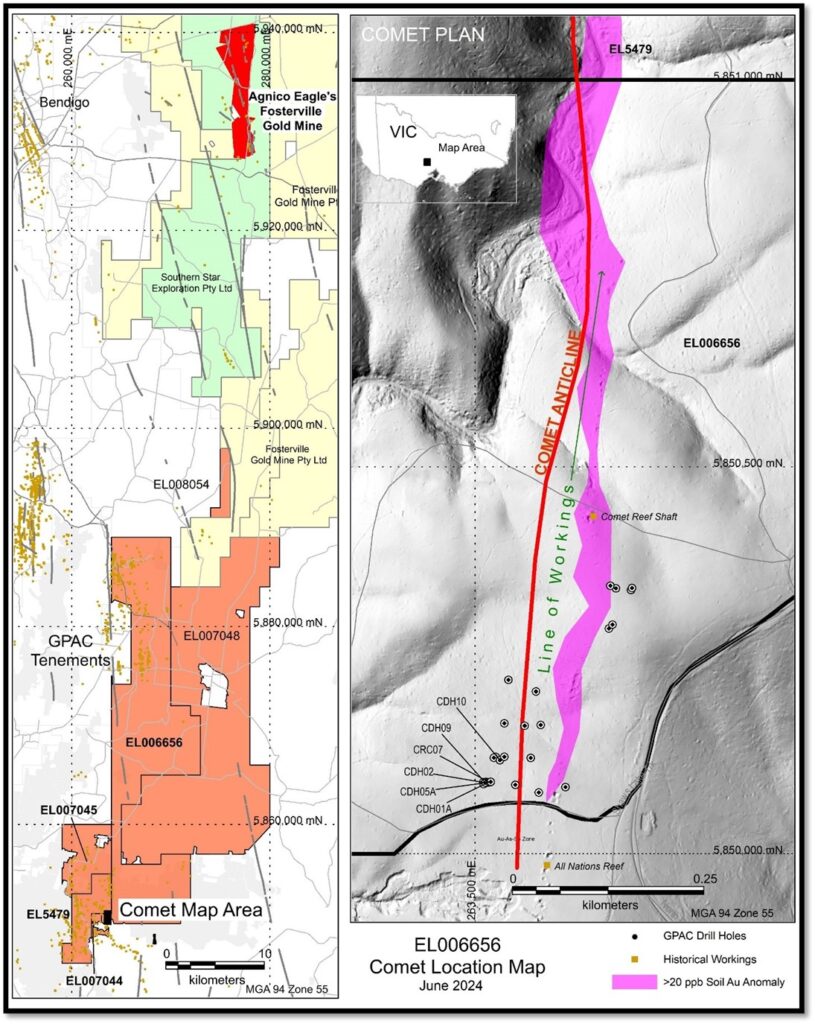
Figure 2 – Updated Comet Cross Section 5850093mN
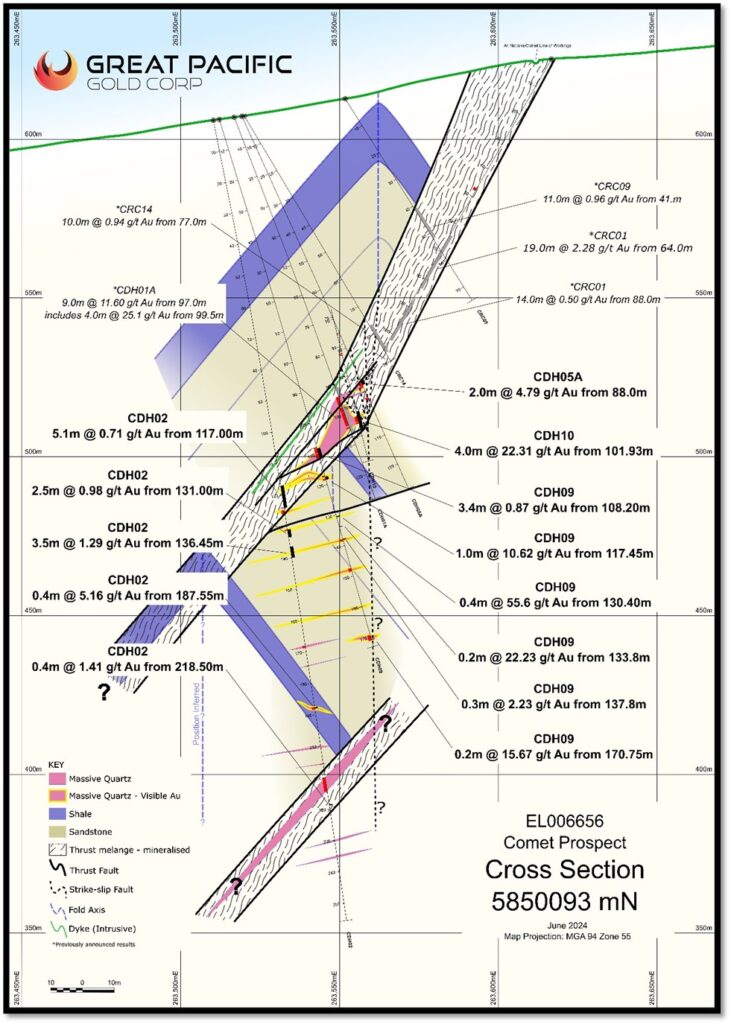
Figure 3 – Visible Gold Contained within CDH10 Quartz Vein Associated with Arsenopyrite and Stibnite needles
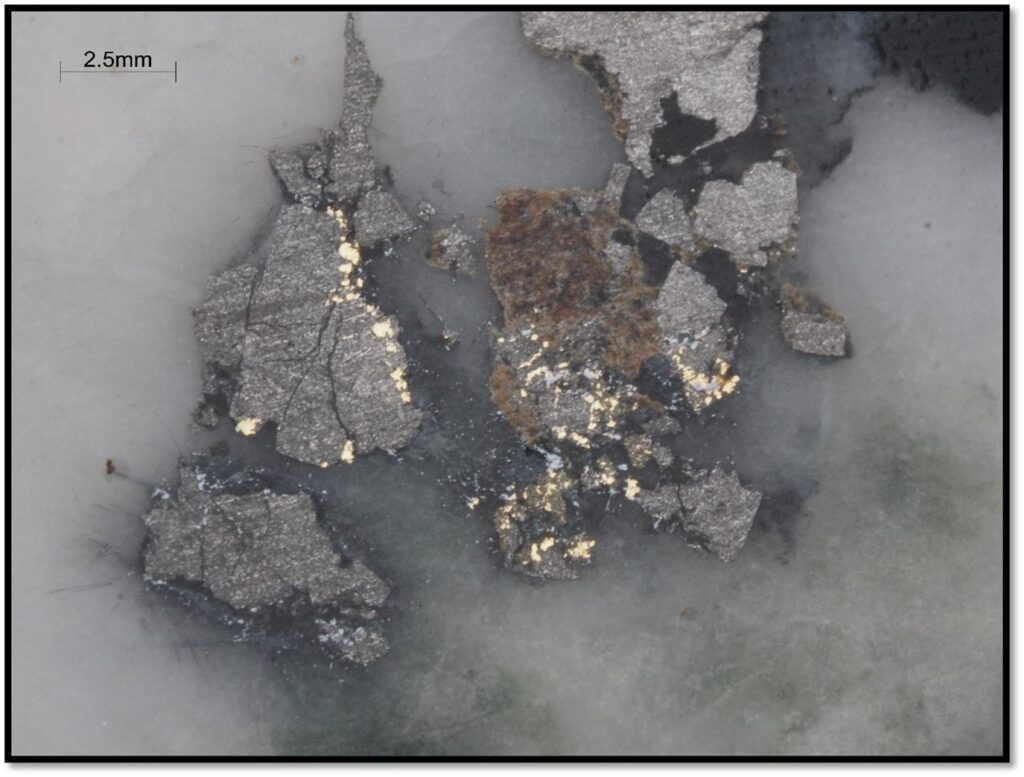
Assays reported in this news release cover nine diamond drill holes totalling 1,380m. See Table 1 for all gold assay results received from the diamond drill program at Comet.
The Comet gold mineralization is hosted by Ordovician slates and sandstones, which are folded in a series of north-south striking concertina folds and regionally form part of the Fosterville Sub-Domain, east of Bendigo. The west dipping thrust fault at Comet, known as the Comet fault zone, is associated with the gold mineralization at the prospect. This high-grade gold discovery is located within the core of the Comet Anticline, where it is intersected by the Comet Fault Zone, which is a similar structural setting of the mineralization present at Fosterville. Further diamond drilling has determined that the Comet anticlinal fold is moved westerly with depth below the main Comet thrust melange – fault zone and that a set of flat lying auriferous extensional quartz veins occurs below the main thrust fault.
The Comet prospect has epizonal characteristics of Au-As-Sb mineralization similar to the Fosterville gold deposit. Other epizonal Victorian projects include the Costerfield and Sunday Creek gold deposits.
A review of the drilling done to date has meant that there remain sections of the drilling that require further core cutting and assaying particularly in the lower part of CDH02 drillhole.
Figure 4 – Deformation model
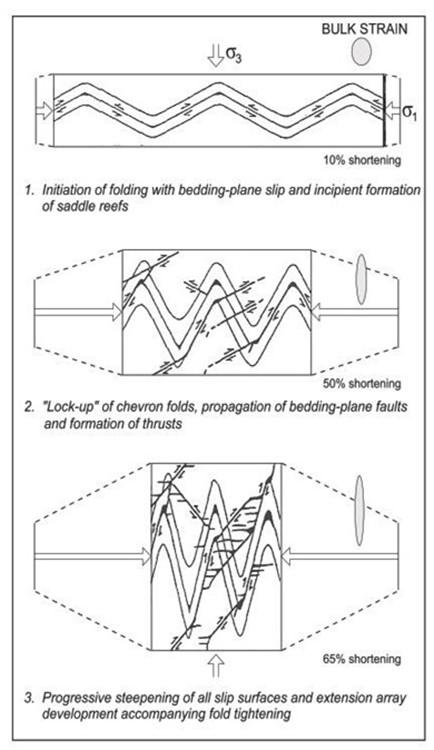
An example of the mechanisms for the development of this large structural framework is presented in Figure 4. East-West compression causes the development of bedding plane slip surfaces, thrusts and extension arrays through progressive coaxial shortening (Sibson and Scott, 1998). West dipping thrust faults and extensional flat lying quartz veining especially in the zone of east dipping beds east of the anticline are dilational and create foci for gold mineralization to occur. Later strike slip faulting disrupted and fractured the gold mineralization previously deposited.
The model indicates that further gold mineralization will occur along the west dipping thrust faults especially when in proximity to the core of the anticline, as well as within the extensional quartz veined array.
Apart from planned drilling along strike, further drilling is planned west of CDH02 to determine the location of the Comet Anticline and Comet Thrust intersection repetition (Figure 5).
Figure 5 – Comet drill targets for further exploration.
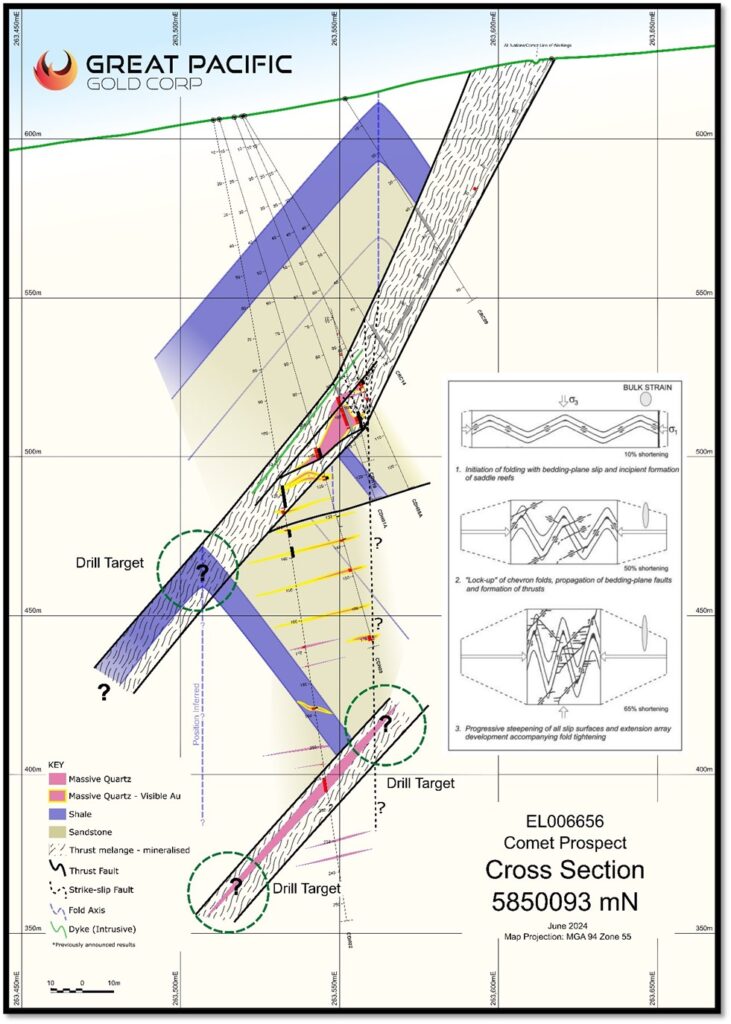
Drill Results and Intercepts:
| HoleID | East | North | Azimuth (deg.) |
Dip (deg.) | From (m) | To (m) | Downhole Interval (m) |
Au g/t |
| CDH02 | 263510.26 | 5850092.31 | 90.12 | -78.7 | 117.0 | 124.1 | 5.1 | 0.71 |
| and | 131.0 | 133.5 | 2.5 | 0.98 | ||||
| and | 136.45 | 140.0 | 3.55 | 1.29 | ||||
| and | 186.7 | 191.1 | 4.4 | 0.72 | ||||
| and | 217.7 | 218.9 | 1.2 | 0.68 | ||||
| CDH03 | 263526.67 | 5850125.28 | 84.22 | -64.6 | 85.0 | 88.0 | 3.0 | 1.03 |
| and | 101.0 | 102.0 | 1.0 | 1.04 | ||||
| CDH04 | 263524.08 | 5850124.16 | 82.72 | -74.8 | 103.0 | 105.0 | 2.0 | 0.60 |
| and | 112.0 | 115.0 | 3.0 | 0.36 | ||||
| and | 148.0 | 149.0 | 1.0 | 0.51 | ||||
| CDH05A | 263519.28 | 8580092.64 | 92.12 | -65.6 | 81.50 | 84.10 | 2.6 | 0.48 |
| and | 86.65 | 87.65 | 1.0 | 0.32 | ||||
| and | 90.95 | 92.95 | 2.0 | 4.79 | ||||
| CDH06 | 263514 | 5850093 | 75 | -63 | 88.90 | 90.00 | 1.85 | 0.67 |
| and | 97.45 | 98.00 | 0.55 | 0.97 | ||||
| and | 100.78 | 102.5 | 2.94 | 0.81 | ||||
| and | 104.95 | 105.30 | 0.4 | 10.90 | ||||
| CDH07 | 263514.03 | 5850093 | 68 | -72 | 105.55 | 115.95 | 10.40 | 1.21 |
| and | 119.25 | 120.65 | 1.4 | 0.64 | ||||
| CDH08 | 263511 | 5850090 | 107 | -70 | 95.9 | 98.2 | 2.3 | 0.66 |
| and | 99.8 | 105.3 | 5.5 | 0.92 | ||||
| and | 107.75 | 110.45 | 2.7 | 2.18 | ||||
| and | 114.6 | 116.9 | 2.3 | 0.35 | ||||
| and | 141.7 | 141.97 | 0.27 | 0.67 | ||||
| and | 151.35 | 151.70 | 0.35 | 0.33 | ||||
| and | 168.75 | 169.3 | 0.55 | 6.26 | ||||
| CDH09 | 263510 | 5850090 | 82 | -73 | 117.45 | 118.45 | 1.0 | 10.62 |
| and | 130.40 | 130.75 | 0.35 | 55.60 | ||||
| and | 133.8 | 134.0 | 0.2 | 22.63 | ||||
| and | 170.75 | 170.95 | 0.2 | 15.67 | ||||
| CDH10 | 263532 | 5850120 | 143 | -69 | 101.9 | 105.9 | 4.0 | 22.3 |
Except for diamond drill holes CDH09 and CDH10 that use a 1.0 g/t Au cut off, the above results use a 0.3 g/t Au cut-off grade and maximum 2m internal waste. True widths are not known due to the complexities of the mineralization. Additional drilling is required to determine true widths. The assays are not capped.
Quality Assurance / Quality Control
All assays were subject to quality control measures appropriate for percussion drilling with duplicates, blanks and commercially available standards with the expected results from the samples submitted. All assays were conducted by Onsite Laboratory Services Ltd (ISO: 9001), located in Bendigo, Victoria, using fire assay techniques with a 25g or 50g charge and ICP or AAS finish. The quality control results are consistent.
About GPAC
Great Pacific Gold has a portfolio of high-grade gold projects in Papua New Guinea (“PNG”) and Australia.
In PNG, Great Pacific Gold recently assembled a 2500 sq. km mineral exploration land package in PNG. The land package comprises of exploration licenses (EL). It includes both early-stage and advanced-stage exploration targets with high-grade epithermal vein and porphyry-style mineralization present.
The Arau Project consists of two exploration licenses, located in the Kainantu region, and includes the Mt. Victor Prospect, where previous drilling found a multiple phase intrusion complex hosting copper and gold mineralization.
The Wild Dog Project consists of two granted exploration licenses, EL 2761 and 2516, located on the island of New Britain and about 50 km southwest of Rabaul and Kokopo, PNG.
The Kesar Creek Project consists of one exploration license, EL 2711, and is contiguous with the K92 Mining Inc. tenements.
The Tinga Valley Project consists of one exploration license, EL 2720. The OK Tedi Copper Gold Mine is 140km to the northwest along the same belt is a superb geological comparison to the Tinga Valley Property.
In Australia, Great Pacific Gold began with two, 100% owned, high-grade gold projects called the Lauriston and Golden Mountain Projects, and has since acquired a large area of granted and application tenements containing further epizonal (low-temperature) high-grade gold mineralization and associated intrusion-related gold mineralization all in the state of Victoria, Australia. The Great Pacific Gold land package, assembled over a multi-year period, notably includes the Lauriston Project which is a 535 sq. km property immediately to the south of and within the same geological framework that hosts Agnico Eagle Mines Ltd’s Fosterville Gold Mine and associated exploration tenements. The Golden Mountain Project is an intrusion-related gold project on the edge of the Strathbogie granite and occurs at the northern end of the Walhalla Gold Belt. The acquired projects include the epizonal gold Providence Project containing the Reedy Creek goldfield which adjoins the Southern Cross Gold’s Sunday Creek exploration project and a large group of recently consolidated granted tenements called the Walhalla Gold Belt Project, which contain a variety of epizonal and intrusion related style gold mineralization. Additionally, Great Pacific Gold has another gold-focused project called the Moormbool Project which has epizonal style gold mineralization and associated potential intrusion-related gold mineralization, as well as the Beechworth Project occurs in the northeast of the state and contains intrusion related and mesozonal gold mineralization.
All GPAC’s properties in Australia are 100% owned and have had historical gold production from hard rock sources despite limited modern exploration and drilling.
Qualified Person
The technical content of this news release has been reviewed, verified and approved by Rex Motton, AusIMM (CP), COO of GPAC, a Qualified Person under the meaning of National Instrument 43-101 – Standards of Disclosure for Mineral Projects. Mr. Motton is responsible for the technical content of this news release.
MORE or "UNCATEGORIZED"
Kuya Silver Confirms High-Grade Silver-Gold Vein Mineralization at Umm-Hadid with Initial Drill Results up to 1483.9 g/t AgEq over 2 Metres
Kuya Silver Corporation (CSE: KUYA) (OTCQB: KUYAF) (FSE: 6MR1) is... READ MORE
First Phosphate Closes Final Tranche of Oversubscribed Private Placement
First Phosphate Corp. (CSE: PHOS) (OTCQX: FRSPF) (FSE: KD0) is... READ MORE
GFG Receives Final Payment from the Sale of its Rattlesnake Hills Gold Project
GFG Resources Inc. (TSX-V: GFG) (OTCQB: GFGSF) announces that i... READ MORE
Goliath Receives $1,730,882 Through Warrant Exercises, Inclusive Of Crescat Capital A Longtime Strategic And Cornerstone Shareholder
Goliath Resources Limited (TSX-V: GOT) (OTCQB: GOTRF) (FSE: B4IF)... READ MORE
Robex Pours First Gold at Kiniéro on Schedule and Budget
Highlights: Gold bar weighing 2.64 kilograms (85 oz) poured in th... READ MORE












